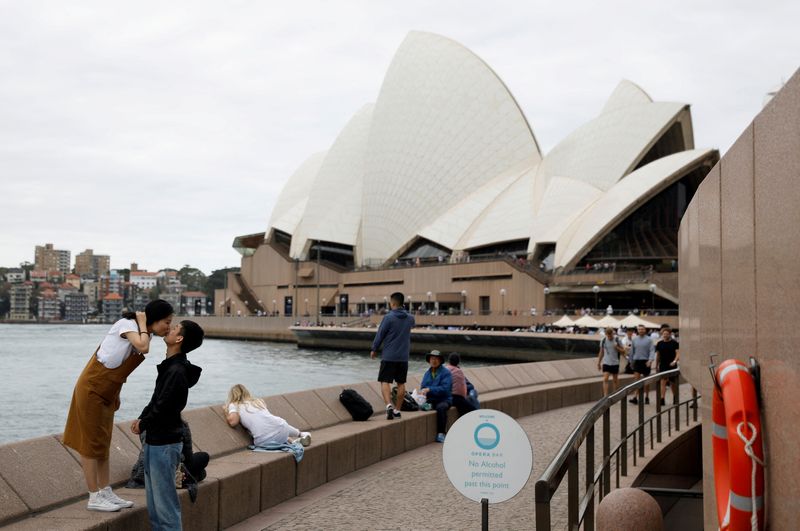Analysis-Great shortfall of China: Australia’s biggest tourism market returns with a whimper
2023.04.16 19:50
3/3

© Reuters. FILE PHOTO: Chinese tourists pose for a photographer (not pictured) near the Sydney Opera House, Australia April 18, 2018. REUTERS/Edgar Su
2/3
By Stella Qiu and Byron Kaye
SYDNEY (Reuters) – When China ended a lengthy border closure in January, e-commerce marketer Tianni Ren immediately began planning a team building trip for her 14 staff to Australia, hoping to see its stunning pink salt lakes that had captivated her on social media.
But instead she took her colleagues from the city of Hangzhou to New Zealand after learning Australia was cut from a list of destinations approved by Beijing for group overseas travel, effectively halting a two-decade programme that had helped China dominate Australia’s A$45 billion ($30 billion) international tourism market until early 2020.
“We asked our tour agent but were told that Australia was not on the group tour list,” said Ren, 28, referring to the Approved Destination Status (ADS) that China gives some 60 other countries. “It is a pity that we did not get to see the pink lakes.”
After three years of struggle and anticipation, the widely expected wave of returning Chinese tourists Down Under has turned out to be a trickle as the visa rules – coupled with relatively high costs, a lack of flights and an exodus of Mandarin-speaking guides – squeeze Australia’s fourth-largest export industry.
In February, the first full month since China’s border reopened, Australia recorded 40,430 short-term visitors from China, government data showed. That was one-fifth the number who visited in the same month in the record year of 2019 and well behind visits from New Zealand, the U.K. and the U.S.
Flights from mainland China to Australia, meanwhile were just one-fifth of pre-pandemic capacity in February, according to aviation analytics firm Cirium, as soaring fuel costs jacked up fares and dented demand.
At the same time, total Chinese outbound border crossings had reached two-thirds of pre-pandemic levels, according to the Chinese Outbound Tourism Research Institute, a consulting group based in Germany.
Beijing did not give a reason for ending Australia’s ADS status, but travel industry participants say geopolitics has played a role, with relations at a low ebb amid trade disputes and increasingly strident security rhetoric between the West and China.
Government marketing body Tourism Australia declined to comment.
Trade promotion office Austrade said Tourism Australia’s managing director visited China in March to meet strategic partners such as airlines and the body would “continue to work closely with its key distribution partners in the market to realise tourism opportunities between Australia and China”.
“It’s definitely tied up in geopolitics and trade and other things where we’ve seen a decline. You can’t disentangle that from the current situation,” said Paul Stolk, a lecturer at University of Newcastle business school who is working on a university-government collaboration to diversify the tourism sector.
In addition, Chinese travellers often choose destinations where family members are studying abroad, Stolk added. China was Australia’s biggest source of foreign students until 2019, but students of other nationalities have filled its foreign student ranks since Australia reopened its border in 2021.
GRAPHIC: Chinese visitors to Australia (
SUPPLY CONSTRAINTS
Australia’s tourism industry is also constrained by lack of foreign language-speaking guides and essential personnel including coach drivers, industry participants said, as the COVID-19 downturn followed by the lowest unemployment level in decades drew workers to other fields.
“We’ve lost a lot of quality staff that know their way around,” said Peter Shelley, managing director at the Australian Tourism Export Council.
“We’re hearing that (Chinese nationals) can’t wait to get out and travel after not being able to travel for so long, and Australia has always been a place that has high aspiration to travel, but our capacity to service has been reduced.”
Some independent Chinese tourists in Australia told Reuters they were visiting because they had relatives in the country who arranged accommodation and tours, meaning they could bypass the language barrier and other issues.
Chien, the ADS-accredited tour agent, said her company has diversified and now caters to solo travellers from elsewhere in Asia.
Travellers from India, for example, returned to 80% of 2019 levels last year and now account for the fourth-largest group of tourists to Australia.
Johnny Nee, Director at Easy Going Travel Services Pty Ltd in Perth, which connects Chinese visitors with hotels and cruises, said his partner organisations had filled the shortfall of Chinese tourists by catering to the domestic market.
“When Chinese tourists return en masse, I’m worried that the supply will not catch up with demand,” he said.
Ren, the marketing director, said her colleagues enjoyed their New Zealand trip where they bought a few Gucci bags, but remained disappointed they missed their first choice of destination.
“I really do hope we can go to Australia next time,” she said. “After all, we cannot stop thinking about the magical pink lakes.”
($1 = 1.4732 Australian dollars)







